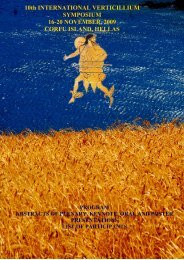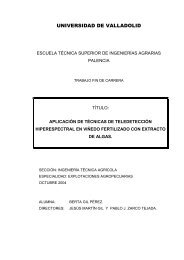Departamento de Física Teórica, Atómica y Óptica - Quantalab ...
Departamento de Física Teórica, Atómica y Óptica - Quantalab ...
Departamento de Física Teórica, Atómica y Óptica - Quantalab ...
You also want an ePaper? Increase the reach of your titles
YUMPU automatically turns print PDFs into web optimized ePapers that Google loves.
ABSTRACT<br />
The Atmospheric Optics Group at the University of Valladolid (GOA-UVA)<br />
focuses on the light-interaction processes with the atmosphere, both in the experimental<br />
context of spectroradiometric measurement as well as in the theoretical research and<br />
<strong>de</strong>velopment of radiative transfer mo<strong>de</strong>ls. This work opens a new research line within<br />
the research group, aimed at the study of the radiative transfer in vegetal canopies. One<br />
of the main objectives is to un<strong>de</strong>rstand the basis for the physical processes that take<br />
place in the interaction between light and vegetation. Progress ma<strong>de</strong> on its measurement<br />
and analysis will enable the un<strong>de</strong>rstanding in obtaining information from the<br />
environment by means of remote sensing tools.<br />
A promising methodology for estimating leaf and canopy biophysical parameters<br />
from spectral reflectance is the inversion of radiative transfer mo<strong>de</strong>ls. Nevertheless, in<br />
spite of international efforts make progress on such objective, current <strong>de</strong>velopments do<br />
not allow an easy and straight forward method for estimating canopy parameters unless<br />
a previous knowledge about the initial conditions of the vegetation are known. The<br />
retrieval of biophysical variables using canopy reflectance mo<strong>de</strong>ls is limited by the fact<br />
that conducting canopy reflectance mo<strong>de</strong>l inversions is an ill-posed problem. This<br />
means that radiative transfer mo<strong>de</strong>ls could simulate a similar reflectance from different<br />
sets of combined input parameters. Therefore, small changes in the measured<br />
reflectance could generate critical differences in the estimated parameters by mo<strong>de</strong>l<br />
inversion. Lately, new research i<strong>de</strong>as suggest using seasonal spectral data as a potential<br />
solution for the ill-posed problem.<br />
This work aims at contributing toward a methodology to improve estimates from<br />
canopy reflectance mo<strong>de</strong>ls, focusing on methods to reduce the ill-posed problem.<br />
Research consisted on two approximations based on multiple analyses of temporal and<br />
spatial datasets, which introduced improvements on the biophysical parameter<br />
estimation by radiative transfer mo<strong>de</strong>l inversion, as compared with traditional methods.<br />
vii




